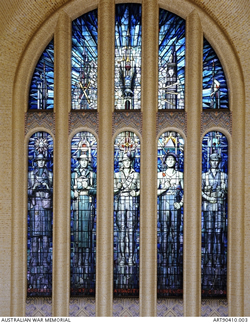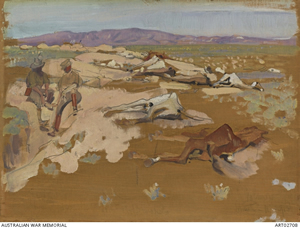Visual arts Stage 5
Overview

Australian War Memorial Hall of Memory: east window designed by Napier Waller, 1950
©Public Domain (AWM ART90410.003)
Students investigate the material practice of Ben Quilty, George Lambert and Napier Wallace. They use a range of materials and artmaking techniques to create works that explore the concept of emotional representation. Students create a large-scale portrait that uses expressive lines to capture emotion and is representative of an aspect of ‘the human condition’. They consider distortion of scale to amplify aspects of emotional paradox.
Teaching and learning activities

Trenches Beersheba, looking towards Tel el Saba, George Lambert, 11 March 1918
©Public Domain (AWM ART02708)
Artmaking – Practice
Key practitioner: Ben Quilty
Students investigate the material practice of Ben Quilty and use a range of materials and artmaking techniques to create works that explore the concept of emotional representation.
Artmaking – Conceptual framework
-
Artist
-
Artwork
-
Audience
-
World
Artmaking – Frames
-
Subjective frame
-
Cultural frame
Students explore the subjective and cultural frames to create works in relation to the artmaking focus area of emotional representation.
Critical and historical studies - Practice
Key practitioners: George Lambert, Napier Waller, Ben Quilty
Students consider conceptual practice of key artists, investigating themes and issues related to three focus areas:
-
Contribution of artists to Australia’s cultural identity 1914–1918
-
Artists as social agents, influenced by and contributing to the social, economic and political conditions of the First World War
-
Influences of politics and economics to the practice of Australian artists during and after the First World War.
Critical and historical studies – Conceptual framework
-
Artist
-
Artwork
-
Audience
-
World
Critical and historical studies – Frames
-
Subjective frame
-
Cultural frame
Students use the subjective and cultural frames to explore the relationships between artists, artworks, audience and the world.
Critical and historical studies
Activity 1
-
Discuss the role of an official war artist, and the responsibility of the artist in creating a personal and informed representation of conflict.
-
Investigate Australian official war artists for the First World War and beyond at the Australian War Memorial site, using the subjective frame and the cultural frame to discuss the works.
-
Discuss the function of the Official War Art Scheme and the contribution of the scheme to the Australian art world as the longest running and largest commissioning program of art in Australia.
Activity 2
-
Use the search function on the Australian War Memorial site to look at works documented in The Anzac Book. Use the cultural frame to discuss the approach to war illustration by First World War soldiers. Ask students to consider why they think this book became a best seller when it was released in 1916.
-
Use the interactive timeline on the ABC site The Art of Australia to identify the period of art for the First World War. Ask students to identify works and artists documented in the timeline during the First World War. Draw attention to the change in documentation in the periods immediately before and after the First World War. Ask key questions such as:
How do works by Lambert and Waller differ? Can you identify which artist was an observer of war and which was a participant of war?
Activity 3
-
Watch The Art of Australia, Episode 2: Coming of Age (2013, Australian Broadcasting Corporation).
-
Listen to Ben Quilty talk about his role as an official war artist during the war in Afghanistan. In Episode 2 he talks about how the role has changed due to the changing role of the media.
-
Discuss the changing role of war artists and key concepts presented by Quilty such as the heroism of war versus the agonies of war. Ask students to find examples of artworks that illustrate the paradox of these roles.
-
Quilty describes the role of contemporary art as ‘more about the human condition than the great big panorama of life… life and death in a war zone’ (The Art of Australia, Episode 2: The Coming of Age, 2013, ABC). Ask students to identify examples of Quilty’s work from Afghanistan that exemplify the human condition. Use the subjective frame to examine emotion and individual experience.
Artmaking
Activity 1
-
Consider the following quote from Ben Quilty about his experience in creating portraits of soldiers in Afghanistan:
‘and all of them, in some sense I think, felt that I made portraits of them the way they felt, rather than the way they looked or heroic portraits of soldiers. It was about the emotion of being there’. From Ben Quilty: after Afghanistan (YouTube) -
View selected works in Quilty’s After Afghanistan: The faces of war. Examine the fluid, expressive qualities of the portraits, and discuss the material choices and technical decisions Quilty has made in relation to the above quote.
-
Create a large-scale portrait that uses expressive lines to capture emotion and is representative of an aspect of ‘the human condition’. Consider distortion of scale to amplify aspects of emotional paradox.
Visual arts references and resources
The Art of Australia, Episode 2: Coming of Age. Australian Broadcasting Corporation and Screen Australia, Serendipity Productions Pty Ltd, Wall to Wall Media Limited, 2013
The Art of Australia: Timeline, Australian Broadcasting Corporation
The ANZAC Book, written and illustrated in Gallipoli by the Men of ANZAC, UNSW Press, Sydney, 2010 Australian War Memorial site search results
Australian official war artists, Australian War Memorial website
Ben Quilty: After Afghanistan, Australian War Memorial website
Ben Quilty: after Afghanistan, Australian War Memorial YouTube channel
Learning concepts
These additional questions can be used for discussion or further investigations.
Challenge
What is the role of an official war artist? What is their responsibility in creating a personal and informed representation of conflict?
How do works by Lambert and Waller differ? Which artist was an observer of war and which was a participant of war?
Change
Discuss the changing role of war artists and key concepts presented by Quilty such as the heroism of war versus the agonies of war. What artworks illustrate the paradox of these roles?
Community
What is the contribution of the Official War Art to the Australian art community as the longest running and largest commissioning program of art in Australia?
Commemoration
How is art used in commemoration of wars?
Syllabus links
Artmaking
5.2 makes artworks informed by their understanding of the function of and relationships between the artist – artwork – world – audience
5.3 makes artworks informed by an understanding of how the frames affect meaning
5.4 investigates the world as a source of ideas, concepts and subject matter in the visual arts
5.5 makes informed choices to develop and extend concepts and different meanings in their artworks
Critical and historical studies
5.7 applies their understanding of aspects of practice to critical and historical interpretations of art
5.8 uses their understanding of the function of and relationship between artist – artwork – world – audience in critical and historical interpretations of art
5.9 demonstrates how the frames provide different interpretations of art
5.10 demonstrates how art criticism and art history construct meanings